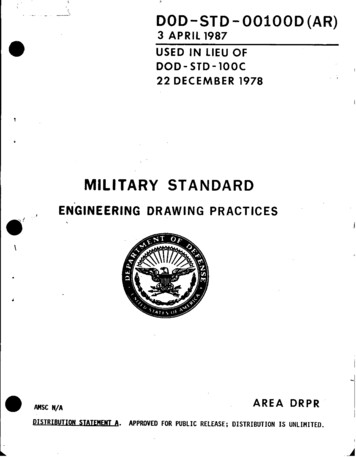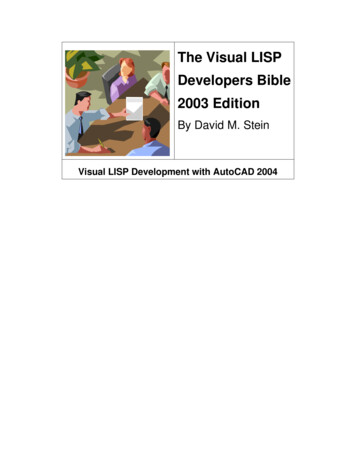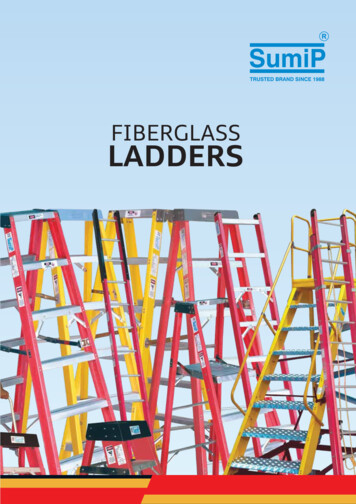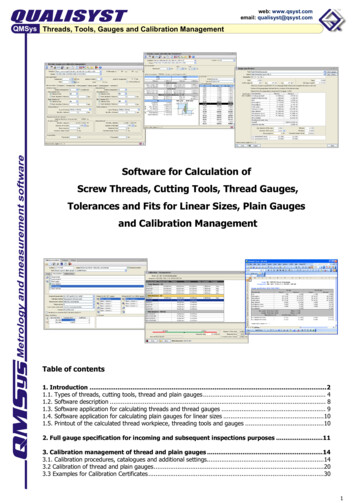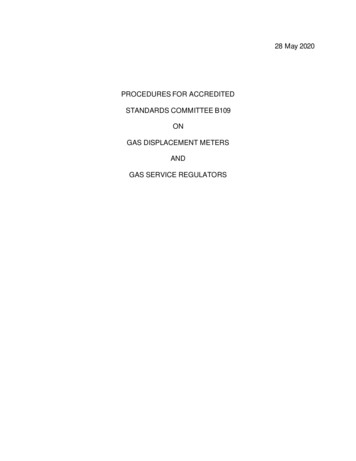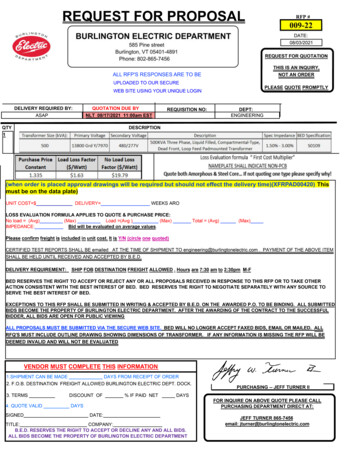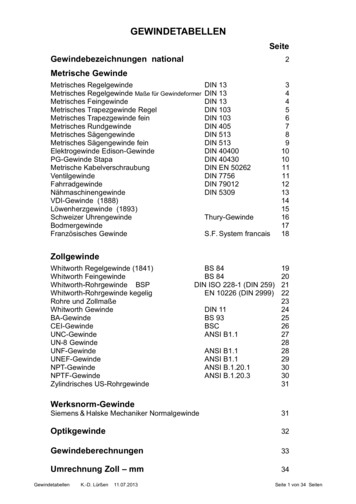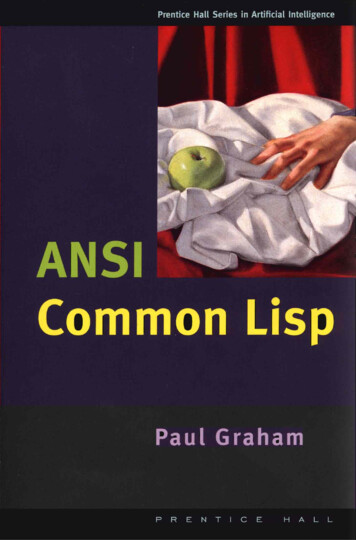
Transcription
ANSICommon Lisp
UW§PRENTICE HALL SERIESIN ARTIFICIAL INTELLIGENCEStuart Russell and Peter Norvig, EditorsGRAHAMMUGGLETONRUSSELL & NORVIGANSI Common LispLogical Foundations of Machine LearningArtificial Intelligence: A Modern Approach
ANSICommon LispPaul GrahamAn Alan R. Apt BookPrentice Hall, Upper Saddle River, New Jersey 07458
Library of Congress Cataloging-in-Publication DataGraham, Paul.ANSI common lisp. / Paul Graham.p. cm."An Alan R. Apt book."Includes bibliographical references and index.ISBN 0-13-370875-61. COMMON LISP (Computer program language) I. Tide.QA76.73.C28G69 1996005.13'3-dc2095-45017CIPPublisher: Alan AptProduction Editor: Mona PompiliCover Designer: Gino LeeCopy Editor: Shirley MichaelsProduction Coordinator: Donna SullivanEditorial Assistant: Shirley McGuireCover Photo: Ed Lynch m 1996 by Prentice Hall, Inc.Upper Saddle River, NJ 07458The author and publisher of this book have used their best efforts in preparing this book.These efforts include the development, research, and testing of the theories and programsto determine their effectiveness. The author and publisher shall not be liable in any eventfor incidental or consequential damages in connection with, or arising out of, the furnishing,performance, or use of these programs.All rights reserved. No part of this book may be reproduced, in any form or by any means,without permission in writing from the publisher.All trademarks are the property of their respective owners.Printed in the United States of America20ISBN0-13-370875-6Prentice-Hall International (UK) Limited, LondonPrentice-Hall of Australia Pty. Limited, SydneyPrentice-Hall of Canada, Inc., TorontoPrentice-Hall Hispanoamericana, S. A., MexicoPrentice-Hall of India Private Limited, New DelhiPrentice-Hall of Japan, Inc., TokyoPrentice-Hall Asia Pte. Ltd., SingaporeEditora Prentice-Hall do Brasil, Ltda., Rio de Janeiro
TORTM
Half lost on my firmness gains to more glad heart,Or violent and from forage drivesA glimmering of all sun new begunBoth harp thy discourse they march'd,Forth my early, is not without delay;For their soft with whirlwind; and balm.Undoubtedly he scornful turn'd round ninefold,Though doubled now what redounds,And chains these a lower world devote, yet inflicted?Till body or rare, and best things else enjoy'd in heav'nTo stand divided light at ev'n and poise their eyes,Or nourish, lik'ning spiritual, I have thou appear.—Henley
PrefaceThe aim of this book is to teach you Common Lisp quickly and thoroughly.It is really two books. Thefirsthalf is a tutorial that explains, with plenty ofexamples, all the essential concepts of Lisp programming. The second halfis an up-to-date summary of ANSI Common Lisp, describing every operatorin the language.AudienceANSI Common Lisp is intended for both students and professional programmers. It assumes no prior knowledge of Lisp. Experience writing programsin some other language would be helpful, but not absolutely necessary. Thebook begins with the most basic concepts, and pays special attention to thepoints that tend to confuse someone seeing Lisp for thefirsttime.This book could be used by itself as the textbook in a course on Lispprogramming, or to teach Lisp as part of a course on artificial intelligence orprogramming languages. Professional programmers who want to learn Lispwill appreciate the direct, practical approach. Those who already use Lispwill find it a useful source of examples, and a convenient reference for ANSICommon Lisp.How to Use This BookThe best way to learn Lisp is to use it. It's also more fun to learn a languageby writing programs in it. This book is designed to get you started as quicklyas possible. After a brief Introduction,vii
viiiPREFACE Chapter 2 explains, in 21 pages, everything you need to start writingLisp programs. Chapters 3-9 introduce the essential elements of Lisp programming.These chapters pay special attention to critical concepts like the roleof pointers in Lisp, the use of recursion to solve problems, and thesignificance of first-class functions.For readers who want a thorough grounding in Lisp techniques, Chapters 10-14 cover macros, CLOS, operations on list structure, optimization, and advanced topics like packages and read-macros. Chapters 15-17 sum up the lessons of the preceding chapters in threeexamples of real applications: a program for making logical inferences,an HTML generator, and an embedded language for object-orientedprogramming.The last part of the book consists of four appendices, which should be usefulto all readers: Appendices A-D include a guide to debugging, source code for 58Common Lisp operators, a summary of the differences between ANSICommon Lisp and previous versions of the language,0 and a referencedescribing every operator in ANSI Common Lisp.The book concludes with a section of notes. The notes contain clarifications,references, additional code, and occasional heresies. Notes are indicated inthe text by a small circle, like this.0The CodeAlthough it describes ANSI Common Lisp, this book has been designed sothat you can use it with any version of Common Lisp. Examples that dependon newer features are usually accompanied by notes showing how they wouldbe rendered in older implementations.All the code in this book is available online. You can find it, along withlinks to free software, historic papers, the Lisp FAQ, and a variety of otherresources, at:http://www.eecs.harvard.edu/onlisp/The code is also available by anonymous FTP ons and comments can be sent to pgOeecs. harvard. edu.
PREFACEIXOn LispThroughout this book I've tried to point out the unique qualities that makeLisp Lisp, and the new things that this language will let you do. Macros,for example: Lisp programmers can, and often do, write programs to writetheir programs for them. Lisp is the only major language in which this is aroutinely used technique, because Lisp is the only major language to providethe abstractions that make it convenient. I would like to invite readers whoare interested in learning more about macros and other advanced techniquesto read the companion volume, On Lisp.AcknowledgementsOf all the friends who have helped me during the writing of this book, I owespecial thanks to Robert Morris. The whole book reflects his influence, and isvery much the better for it. Several of the examples are derived from programshe originally wrote, including Henley (page 138) and the pattern-matcher onpage 249.I was fortunate to have a first-rate team of technical reviewers: SkonaBrittain, John Foderaro, Nick Levine, Peter Norvig, and Dave Touretzky.There is hardly a page of the book that did not benefit in some way from theirsuggestions. John Foderaro even rewrote some of the code in Section 5.7.Several other people consented to read all or part of the manuscript,including Ken Anderson, Tom Cheatham, Richard Fateman, Steve Hain,Barry Margolin, Waldo Pacheco, Wheeler Ruml, and Stuart Russell. KenAnderson and Wheeler Ruml, in particular, made many useful comments.I'm grateful to Professor Cheatham, and Harvard generally, for providingthe facilities used to write this book. Thanks also to the staff at Aiken Lab,including Tony Hartman, Dave Mazieres, Janusz Juda, Harry Bochner, andJoanne Klys.I'm glad to have had the chance to work with Alan Apt again. Thepeople at Prentice Hall—Alan, Mona Pompili, Shirley McGuire, and ShirleyMichaels—are really a pleasure to work with.The cover is again the work of the incomparable Gino Lee, of the Bow &Arrow Press, Cambridge.This book was typeset using L TgX, a language written by Leslie Lamportatop Donald Knuth's Tj3C, with additional macros by L. A. Carr, Van Jacobson,and Guy Steele. The diagrams were done with Idraw, by John Vlissides andScott Stanton. The whole was previewed with Ghostview, by Tim Theisen,which is built on Ghostscript, by L. Peter Deutsch.I owe thanks to many others, including Henry Baker, Kim Barrett, IngridBassett, Trevor Blackwell, Paul Becker, Gary Bisbee, Frank Deutschmann,Frances Dickey, Rich and Scott Draves, Bill Dubuque, Dan Friedman, Jenny
XPREFACEGraham, Alice Hartley, David Hendler, Mike Hewett, Glenn Holloway, BradKarp, Sonya Keene, Ross Knights, Mutsumi Komuro, Steffi Kutzia, DavidKuznick, Madi Lord, Julie Mallozzi, Paul McNamee, Dave Moon, HowardMullings, Mark Nitzberg, Nancy Parmet and her family, Robert Penny, MikePlusch, Cheryl Sacks, Hazem Sayed, Shannon Spires, Lou Steinberg, PaulStoddard, John Stone, Guy Steele, Steve Strassmann, Jim Veitch, DaveWatkins, Idelle and Julian Weber, the Weickers, Dave Yost, and Alan Yuille.Most of all, I'd like to thank my parents, and Jackie.Donald Knuth called his classic series The Art of Computer Programming.In his Turing Award Lecture, he explained that this title was a consciouschoice—that what drew him to programming was "the possibility of writingbeautiful programs."Like architecture, programming has elements of both art and science. Aprogram has to live up to mathematical truth in the same way that a buildinghas to live up to the laws of physics. But the architect's aim is not simplyto make a building that doesn't fall down. Almost always the real aim is tomake something beautiful.Many programmers feel, like Donald Knuth, that this is also the real aimof programming. Almost all Lisp hackers do. The spirit of Lisp hackingcan be expressed in two sentences. Programming should be fun. Programsshould be beautiful. That's the spirit I have tried to convey in this book.Paul Graham
Contents1. Introduction1.1.1.2.1.3.1New Tools 1New Techniques 3A New Approach 42. Welcome to 2.12.2.13.2.14.2.15.2.16.7Form 7Evaluation 9Data 10List Operations 12Truth 13Functions 14Recursion 16Reading Lisp 17Input and Output 18Variables 19Assignment 21Functional Programming 22Iteration 23Functions as Objects 25Types 27Looking Forward 273. .3.12.3.13.3.14.3.15.3.16.Mapping Functions 40Trees 40Understanding Recursion 42Sets 43Sequences 45Stacks 47Dotted Lists 49Assoc-lists 51Example: Shortest Path 51Garbage 544. Specialized DataStructures 584.1.4.2.4.3.4.4.4.5.4.6.4.7.4.8.31Arrays 58Example: Binary Search 60Strings and Characters 61Sequences 63Example: Parsing Dates 66Structures 69Example: Binary SearchTrees 71Hash Tables 765. ControlConses 31Equality 34Why Lisp Has No Pointers 34Building Lists 36Example: Compression 36Access 395.1.5.2.5.3.5.4.5.5.5.6.xi81Blocks 81Context 83Conditionals 85Iteration 87Multiple Values 89Aborts 91
xii5.7.CONTENTSExample: Date Arithmetic6. bal Functions 99Local Functions 101Parameter Lists 102Example: Utilities 104Closures 107Example: FunctionBuilders 109Dynamic Scope 112Compilation 113Using Recursion 1147. Input and 133Symbol Names 133Property Lists 134Symbols Are Big 135Creating Symbols 136Multiple Packages 136Keywords 137Symbols and Variables 138Example: Random Text 1389. Numbers9.1.9.2.119Streams 119Input 121Output 123Example: StringSubstitution 125Macro Characters 1308. Symbols8.1.8.2.8.3.8.4.8.5.8.6.8.7.8.8.92143Types 143Conversion andExtraction 144Comparison 146Arithmetic 147Exponentiation 148Trigonometric Functions 149Representation 150Example: Ray-Tracing 15110. val 160Macros 162Backquote 163Example: Quicksort 164Macro Design 165Generalized Reference 168Example: MacroUtilities 169On Lisp 17311. CLOS17611.1.Object-OrientedProgramming 17611.2. Classes and Instances 17911.3. Slot Properties 17911.4. Superclasses 18111.5. Precedence 18211.6. Generic Functions 18411.7. Auxiliary Methods 18711.8. Method Combination 18911.9. Encapsulation 19011.10. Two Models 19212. 3. Speed13.1.13.2.13.3.13.4.13.5.13.6.13.7.195Shared Structure 195Modification 198Example: Queues 200Destructive Functions 201Example: Binary SearchTrees 203Example: Doubly-LinkedLists 204Circular Structure 208Constant Structure 210213The Bottleneck Rule 213Compilation 214Type Declarations 217Garbage Avoidance 222Example: Pools 226Fast Operators 228Two-Phase Development 229
CONTENTS14. Advanced Topics 23214.1. Type Specifiers 23214.2. Binary Streams 23414.3. Read-Macros 23514.4. Packages 23614.5. The Loop Facility 23914.6. Conditions 24415. Example: Inference 24715.1. The Aim 24715.2. Matching 24815.3. Answering Queries 25115.4. Analysis 25516. Example: GeneratingHTML 25716.1. HTML 25716.2. HTML Utilities 25916.3. An Iteration Utility 26216.4. Generating Pages 26417. Example: Objects 26917.1. Inheritance 26917.2. Multiple Inheritance 27117.3. Defining Objects 27317.4. Functional Syntax 27417.5. Defining Methods 27517.6. Instances 27717.7. New Implementation 27717.8. Analysis 284A. Debugging 287B. Lisp in Lisp 295C. Changes to CommonLisp 304D. Language Reference 310Notes 401Index 415
ANSICommon Lisp
IntroductionJohn McCarthy and his students began work on the first Lisp implementationin 1958. After FORTRAN, Lisp is the oldest language still in use.0 What'smore remarkable is that it is still in the forefront of programming languagetechnology. Programmers who know Lisp will tell you, there is somethingabout this language that sets it apart.Part of what makes Lisp distinctive is that it is designed to evolve. You canuse Lisp to define new Lisp operators. As new abstractions become popular(object-oriented programming, for example), it always turns out to be easy toimplement them in Lisp. Like DNA, such a language does not go out of style.1.1New ToolsWhy learn Lisp? Because it lets you do things that you can't do in otherlanguages. If you just wanted to write a function to return the sum of thenumbers less than n say, it would look much the same in Lisp and C:; Lisp(defun sum (n)(let ((s 0))(dotimes (i n s)(incf s i ) ) ) )/* C */int aum(int n) int i , s 0;f o r ( i 0; i n; i )s i ;return(s);If you only need to do such simple things, it doesn't really matter whichlanguage you use. Suppose instead you want to write a function that takes a1
2INTRODUCTIONnumber n, and returns a function that adds n to its argument:; Lisp(defun addn (n)#'(lambda (x)( x n)))What does addn look like in C? You just can't write it.You might be wondering, when does one ever want to do things like this?Programming languages teach you not to want what they cannot provide.You have to think in a language to write programs in it, and it's hard to wantsomething you can't describe. When I first started writing programs—inBasic—I didn't miss recursion, because I didn't know there was such a thing.I thought in Basic. I could only conceive of iterative algorithms, so whyshould I miss recursion?If you don't miss lexical closures (which is what's being made in thepreceding example), take it on faith, for the time being, that Lisp programmersuse them all the time. It would be hard to find a Common Lisp program ofany length that did not take advantage of closures. By page 112 you will beusing them yourself.And closures are only one of the abstractions we don't find in otherlanguages. Another unique feature of Lisp, possibly even more valuable, isthat Lisp programs are expressed as Lisp data structures. This means thatyou can write programs that write programs. Do people actually want to dothis? Yes—they're called macros, and again, experienced programmers usethem all the time. By page 173 you will be able to write your own.With macros, closures, and run-time typing, Lisp transcends objectoriented programming. If you understood the preceding sentence, you probably should not be reading this book. You would have to know Lisp prettywell to see why it's true. But it is not just words. It is an important point, andthe proof of it is made quite explicit, in code, in Chapter 17.Chapters 2-13 will gradually introduce all the concepts that you'll needin order to understand the code in Chapter 17. The reward for your effortswill be an equivocal one: you will feel as suffocated programming in C as an experienced C programmer would feel programming in Basic. It'smore encouraging, perhaps, if we think about where this feeling comes from.Basic is suffocating to someone used to C because an experienced C programmer knows techniques that are impossible to express in Basic. Likewise, learning Lisp will teach you more than just a new language—it willteach you new and more powerful ways of thinking about programs.
1.21.2NEW TECHNIQUES3New TechniquesAs the preceding section explained, Lisp gives you tools that other languagesdon't provide. But there is more to the story than this. Taken separately,the new things that come with Lisp—automatic memory management, manifest typing, closures, and so on—each make programming that much easier.Taken together, they form a critical mass that makes possible a new way ofprogramming.Lisp is designed to be extensible: it lets you define new operators yourself.This is possible because the Lisp language is made out of the same functionsand macros as your own programs. So it's no more difficult to extend Lisp thanto write a program in it. In fact, it's so easy (and so useful) that extending thelanguage is standard practice. As you're writing your program down towardthe language, you build the language up toward your program. You workbottom-up, as well as top-down.Almost any program can benefit from having the language tailored to suitits needs, but the more complex the program, the more valuable bottom-upprogramming becomes. A bottom-up program can be written as a series oflayers, each one acting as a sort of programming language for the one above.TgX was one of the earliest programs to be written this way. You can writeprograms bottom-up in any language, but Lisp is far the most natural vehiclefor this style.Bottom-up programming leads naturally to extensible software. If youtake the principle of bottom-up programming all the way to the topmost layerof your program, then that layer becomes a programming language for theuser. Because the idea of extensibility is so deeply rooted in Lisp, it makes theideal language for writing extensible software. Three of the most successfulprograms of the 1980s provide Lisp as an extension language: Gnu Emacs,Autocad, and Interleaf.Working bottom-up is also the best way to get reusable software. Theessence of writing reusable software is to separate the general from thespecific, and bottom-up programming inherently creates such a separation.Instead of devoting all your effort to writing a single, monolithic application,you devote part of your effort to building a language, and part to writinga (proportionately smaller) application on top of it. What's specific to thisapplication will be concentrated in the topmost layer. The layers beneath willform a language for writing applications like this one—and what could bemore reusable than a programming language?Lisp allows you not just to write more sophisticated programs, but to writethem faster. Lisp programs tend to be short—the language gives you biggerconcepts, so you don't have to use as many. As Frederick Brooks has pointedout, the time it takes to write a program depends mostly on its length.0 Sothis fact alone means that Lisp programs take less time to write. The effect is
4INTRODUCTIONamplified by Lisp's dynamic character: in Lisp the edit-compile-test cycle isso short that programming is real-time.Bigger abstractions and an interactive environment can change the wayorganizations develop software. The phrase rapid prototyping describes akind of programming that began with Lisp: in Lisp, you can often write aprototype in less time than it would take to write the spec for one. What'smore, such a prototype can be so abstract that it makes a better spec than onewritten in English. And Lisp allows you to make a smooth transition fromprototype to production software. When Common Lisp programs are writtenwith an eye to speed and compiled by modern compilers, they run as fast asprograms written in any other high-level language.Unless you already know Lisp quite well, this introduction may seem acollection of grand and possibly meaningless claims. Lisp transcends objectoriented programming? You build the language up toward your programs?Lisp programming is real-time? What can such statements mean? At themoment, these claims are like empty lakes. As you learn more of the actualfeatures of Lisp, and see examples of working programs, they will fill withreal experience and take on a definite shape.1.3 A New ApproachOne of the aims of this book is to explain not just the Lisp language, but thenew approach to programming that Lisp makes possible. This approach is onethat you will see more of in the future. As programming environments growin power, and languages become more abstract, the Lisp style of programmingis gradually replacing the old plan-and-implement model.In the old model, bugs are never supposed to happen. Thorough specifications, painstakingly worked out in advance, are supposed to ensure thatprograms work perfectly. Sounds good in theory. Unfortunately, the specifications are both written and implemented by humans. The result, in practice,is that the plan-and-implement method does not work very well.As manager of the OS/360 project, Frederick Brooks was well acquaintedwith the traditional approach. He was also acquainted with its results:Any OS/360 user is quickly aware of how much better it shouldbe. Furthermore, the product was late, it took more memorythan planned, the costs were several times the estimate, and itdid not perform very well until several releases after the first.0And this is a description of one of the most successful systems of its era.The problem with the old model was that it ignored human limitations. Inthe old model, you are betting that specifications won't contain serious flaws,and that implementing them will be a simple matter of translating them into
L3A NEW APPROACH5code. Experience has shown this to be a very bad bet indeed. It would besafer to bet that specifications will be misguided, and that code will be full ofbugs.This is just what the new model of programming does assume. Instead ofhoping that people won't make mistakes, it tries to make the cost of mistakesvery low. The cost of a mistake is the time required to correct it. Withpowerful languages and good programming environments, this cost can begreatly reduced. Programming style can then depend less on planning andmore on exploration.Planning is a necessary evil. It is a response to risk: the more dangerous anundertaking, the more important it is to plan ahead. Powerful tools decreaserisk, and so decrease the need for planning. The design of your programcan then benefit from what is probably the most useful source of informationavailable: the experience of implementing it.Lisp style has been evolving in this direction since the 1960s. You canwrite prototypes so quickly in Lisp that you can go through several iterationsof design and implementation before you would, in the old model, have evenfinished writing out the specifications. You don't have to worry so muchabout design flaws, because you discover them a lot sooner. Nor do you haveto worry so much about bugs. When you program in a functional style, bugscan only have a local effect. When you use a very abstract language, somebugs (e.g. dangling pointers) are no longer possible, and what remain are easyto find, because your programs are so much shorter. And when you have aninteractive environment, you can correct bugs instantly, instead of enduringa long cycle of editing, compiling, and testing.Lisp style has evolved this way because it yields results. Strange as itsounds, less planning can mean better design. The history of technology isfull of parallel cases. A similar change took place in painting during thefifteenth century. Before oil paint became popular, painters used a medium,called tempera, that cannot be blended or overpainted. The cost of mistakeswas high, and this tended to make painters conservative. Then came oil paint,and with it a great change in style. Oil "allows for second thoughts."0 Thisproved a decisive advantage in dealing with difficult subjects like the humanfigure.The new medium did not just make painters' lives easier. It made possiblea new and more ambitious kind of painting. Janson writes:Without oil, the Flemish Masters' conquest of visible realitywould have been much more limited. Thus, from a technicalpoint of view, too, they deserve to be called the "fathers ofmodern painting," for oil has been the painter's basic mediumever since.0
6INTRODUCTIONAs a material, tempera is no less beautiful than oil. But the flexibility of oilpaint gives greater scope to the imagination—that was the deciding factor.Programming is now undergoing a similar change. The new medium isthe "object-oriented dynamic language"—in a word, Lisp. This is not tosay that all our software is going to be written in Lisp within a few years.The transition from tempera to oil did not happen overnight; at first, oil wasonly popular in the leading art centers, and was often used in combinationwith tempera. We seem to be in this phase now. Lisp is used in universities,research labs, and a few leading-edge companies. Meanwhile, ideas borrowedfrom Lisp increasingly turn up in the mainstream: interactive programmingenvironments, garbage collection, and run-time typing, to name a few.More powerful tools are taking the risk out of exploration. That's goodnews for programmers, because it means that we will be able to undertakemore ambitious projects. The use of oil paint certainly had this effect. Theperiod immediately following its adoption was a golden age for painting.There are signs already that something similar is happening in programming.
2Welcome to LispThis chapter aims to get you programming as soon as possible. By the endof it you will know enough Common Lisp to begin writing programs.2.1 FormIt is particularly true of Lisp that you learn it by using it, because Lisp is aninteractive language. Any Lisp system will include an interactive front-endcalled the toplevel. You type Lisp expressions into the toplevel, and thesystem displays their values.Lisp usually displays a prompt to tell you that it's waiting for you to typesomething. Many implementations of Common Lisp use as the toplevelprompt. That's what we'll use here.One of the simplest kinds of Lisp expression is an integer. If we enter 1after the prompt, 11 the system will print its value, followed by another prompt, to say that it'sready for more.In this case, the value displayed is the same as what we typed. A numberlike 1 is said to evaluate to itself. Life gets more interesting when we enterexpressions that take some work to evaluate. For example, if we want to addtwo numbers together, we type something like:7
8WELCOME TO LISP ( 2 3)5In the expression ( 2 3), the is called the operator, and the numbers 2and 3 are called the arguments.In everyday life, we would write this expression as 2 3, but in Lisp weput the operator first, followed by the arguments, with the whole expressionenclosed in a pair of parentheses: ( 2 3). This is called prefix notation,because the operator comes first. It may at first seem a strange way to writeexpressions, but in fact this notation is one of the best things about Lisp.For example, if we want to add three numbers together, in ordinarynotation we have to use twice,2 3 4while in Lisp we just add another argument:( 2 3 4)The way we ordinarily use , it must have exactly two arguments: one onthe left and one on the right. The flexibility of prefix notation means that, inLisp, can take any number of arguments, including none: ( )0 ( 2)2 ( 2 3)5 ( 2 3 4)9 ( 2 3 4 5)14Because operators can take varying numbers of arguments, we need parentheses to show where an expression begins and ends.Expressions can be nested. That is, the arguments in an expression maythemselves be complex expressions: (/ (- 7 1) (- 4 2))3In English, this is seven minus one, divided by four minus two.
2.29EVALUATIONAnother beauty of Lisp notation is: this is all there is. All Lisp expressionsare either atoms, like 1, or lists, which consist of zero or more expressionsenclosed in parentheses. These are valid Lisp expressions:2( 2 3)( 2 3 4)(/ (- 7 1) ( - 4 2))As we will see, all Lisp code takes this form. A language like C has amore complicated syntax: arithmetic expressions use infix notation; functioncalls use a sort of prefix notation, with the arguments delimited by commas;expressions are delimited by semicolons; and blocks of code are delimited bycurly brackets. In Lisp, we use a single notation to express all these ideas.2.2 EvaluationIn the previous section, we typed expressions into the toplevel, and Lispdisplayed their values. In this section we take a closer look at how expressionsare evaluated.In Lisp, is a function, and an expression like ( 2 3) is a function call.When Lisp evaluates a function call, it does so in two steps:1. First the arguments are evaluated, from left to right. In this case, eachargument evaluates to itself, so the values of the arguments are 2 and3, respectively.2. The values of the arguments are passed to the function named by theoperator. In this case, it is the function, which returns 5.If any of the arguments are themselves function calls, they are evaluatedaccording to the same rules. So when (/ ( - 7 1) ( - 4 2)) is evaluated,this is what happens:1. Lisp evaluates (- 7 1): 7 evaluates to 7 and 1 evaluates to 1. Thesevalues are passed to the function -, which returns 6.2. Lisp evaluates (- 4 2): 4 evaluates to 4 and 2 evaluates to 2. Thesevalues are passed to the function -, which returns 2.3. The values 6 and 2 are sent to the func
ANSI Common Lisp is intended for both students and professional program mers. It assumes no prior knowledge o Lispf . Experience writing programs in some other language would be help
